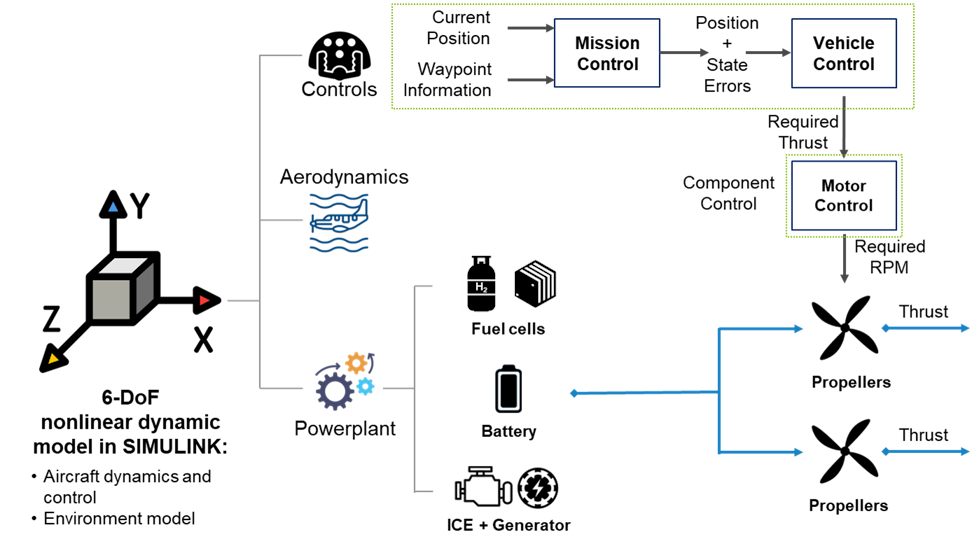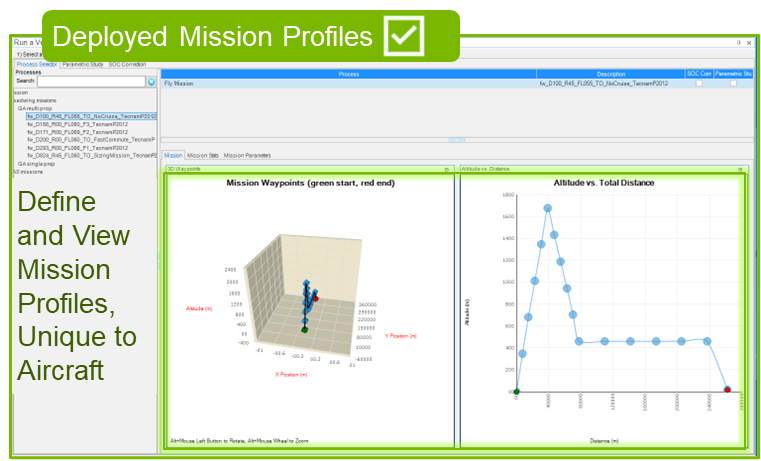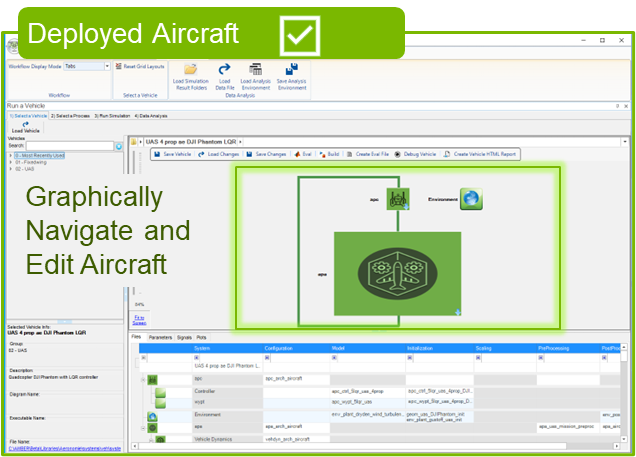Aeronomie
Aircraft Propulsion and Flight Dynamics Simulator for Low-Carbon Aviation Research
Aeronomie is an aircraft simulation tool used for research on next-generation zero-carbon and low-carbon aircraft, for both commercial aviation, as well as advanced air mobility concepts. Thanks to its library of predefined whole aircraft and subsystems, and through a professional GUI, users can with a few clicks explore various designs options and the trade-off between energy consumption, range, endurance and payload. Aeronomie is well suited for the exploration of alternative propulsion and powertrain options, such as hybrid, all-electric and hydrogen.
Aeronomie integrates two decades worth of development and maturation in systems modeling and tool development, sharing its DNA with tools deployed in the automotive sector, Autonomie and AMBER. For example, a whole aircraft model is made from models of its subsystems, including powerplant components, propulsion, aerodynamics, flight dynamics, and pilot/controls. Prior to simulation, Aeronomie automatically builds that whole aircraft model from the subsystem models following an architecture that can be easily changed by the user. This unique feature saves time and fosters code reusability when exploring different kinds of aircraft classes or propulsion configurations. The tool offers a high-level of customization, whether it is parametrizing from the GUI, editing the Matlab/Simulink models, or even importing new models altogether.
Contact us to request a license.
Use Cases
- Aircraft electrification: explore aircraft electrification options, such as hybrid ICE-Electric, all-electric, hybrid Battery-Hydrogen fuel cell.
- Powerplant architectures: compare different powerplant architectures, e.g. series or parallel configuration for a hybrid-electric aircraft.
- Sizing: study the impact of component sizing on flight performance, e.g. fuel cell power for a hydrogen-powered aircraft.
- Requirements: define targets and requirements for components, e.g. battery specific energy (Wh/kg) to meet certain aircraft range and payload requirements.
- Operating profiles: study individual component operations during a flight mission, e.g. current profile of the battery in an all-electric aircraft.
- Energy Management: develop and optimize energy management strategy for advanced propulsion concepts, e.g. power split between ICE and battery in a hybrid-electric aircraft.
- Control & optimization: Develop and optimize flight controls and trajectory to minimize energy consumption.
- Hardware-in-the-loop (HIL): perform hardware-in-the-loop experimentation, e.g. motor-in-the-loop, where the motor is real and tied to a dynamometer, while the rest of the aircraft is virtual.
Research Highlights
- Small commuter aircraft with hybrid-electric propulsion: we simulated the implementation of new sustainable powerplants on a small 9-pax commuter aircraft with Aeronomie. Results show that retrofit electrification could be possible with battery specific energy of 450 Wh/kg (pack level). Well-to-Wake CO2 emissions using US energy mix [kgCO2/km] are lowered by 73% for the all-electric, 52% for the fuel-cell hybrid-electric, and 2% for the series hybrid-electric (paper).
- Vectored-thrust urban air mobility vehicle simulation: we developed a model of a eVTOL similar to the Joby S4 in Aeronomie. It was observed that the Joby S4 requires 300% more power to be able to climb vertically in the rotorcraft configuration than during cruise in the fixed wing configuration, suggesting the need to quickly transition from the rotorcraft configuration to the much more efficient fixed wing configuration (paper).
More Argonne papers supported by Aeronomie in our Zotero library.
Predefined Aircraft Models
- Single-propeller piston-ICE trainer plane
- Twin-engine commuter plane, in piston-ICE and all-electric variants
- Small Quadcopter and Hexacopter drone/UAV
- Coming soon: hybrid-electric and fuel cell powerplant variants, turbine engines, vectored-thrust eVTOL aircraft
Models For All Subsystems
- Power & propulsion: piston ICE, electric motor, battery, fuel cell, storage tanks, propellers, etc. Jet engine/turbine coming soon.
- Aerodynamics, such as drag and lift polars and other longitudinal and lateral aerodynamic coefficients. Coupled with 3rd party tools, such as OpenVSP for generating these coefficients from geometric designs.
- Flight dynamics, with 6 degrees-of-freedom motion, for fixed-wing and rotorcraft (e.g. quadcopter). Coming soon: in-flight transition from rotorcraft to fixed-wing dynamics (e.g. in vectored-thrust eVTOLs)
- Controls: pilot model for flight/waypoint navigation, energy management, subsystem controls (e.g. pro-peller speed control). Coming soon: trajectory planning
- Missions: library of pre-existing missions adapted to different aircraft classes
- Take-off/landing: coming soon.
 Schematic representation of an Aeronomie aircraft architecture
Schematic representation of an Aeronomie aircraft architecture
Structured Modeling
- Customizable: all models and model-related files are open and can be modified for internal use by users, and users can import their own model libraries.
- Matlab/Simulink-based: all models are written in Matlab/Simulink language and are editable.
- Co-simulation and third-party tools: if a 3rd-party tool can link to Simulink (e.g. via S-function), it can run with Aeronomie. A typical use case would be to replace one component model with a higher-fidelity model from another tool.
- High-frequency simulation: typical simulation time step is 10 ms, enabling simulation of dynamic responses and transient dynamics.
- Forward-looking: the models are “forward-looking”, i.e. actions (such as motion) are the result of pilot or control commands based on observation of current state of the system. These commands result in the production of efforts (e.g. force, torque, voltage) which are propagated forward (i.e. from energy storage towards propulsion actuator), themselves causing flows (e.g. linear speed, rotational speed, current) which are propagated backward. This type of modeling accurately represent causality and is essential for dynamic control development.
- Modular architecture: the whole aircraft model is made of models of subsystems, which can themselves be sub-divided into subsystems, and so on. How these models connect to each other is defined by human-readable metafiles (in XML). This provides both structure and flexibility in how models are designed, enhancing collaborative model development.
Ease-of-Use & Customizability
- End-to-end simulation workflow: Aeronomie manages the various steps of the simulation workflow: model setup, mission definition, model building and initialization, simulation, post-processing, results storage and results visualization.
- Automated model building: Aeronomie creates a whole aircraft model from scratch before each simulation, from elemental subsystem models (e.g. motor plant), architecture description and optional one-off customization by user. This provides a natural framework for code reusability and collaborative model development.
- Graphical User Interface (GUI): Aeronomie comes with a powerful GUI from which the end user can modify and visualize all steps of the simulation workflow, without the need to write any code. The GUI also facilitates customization of models and workflows. For example, user can select preferred display units, regardless of units used in the models.
- Command-line API: advanced users can expand the capabilities of the GUI by managing the simulation workflow from command line or Matlab scripts/functions thanks to a powerful API.
- File management system: all files end users may interact with (Simulink models, pre-/post-processing files, architectures, simulation results, etc.) are associated with XML-based metadata, enabling easy integration with GUI and consistency for collaborative work.
- Integration with source control. Aeronomie’s GUI can integrate source-controlled user libraries.
 Aeronomie GUI: Mission selection window with aircraft specific mission and both 2D, and 3D mission profiles.
Aeronomie GUI: Mission selection window with aircraft specific mission and both 2D, and 3D mission profiles.
 Aeronomie GUI: Aircraft selection window highlights the ability to view/modify the aircraft from the GUI.
Aeronomie GUI: Aircraft selection window highlights the ability to view/modify the aircraft from the GUI.
Release History & News
February 2024. Aeronomie Beta 2024 released.
Software Requirements
- For Matlab requirements, see our FAQ
- For Windows Operating System requirements, see our installation support page